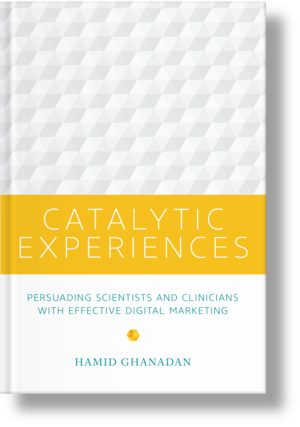Catalytic experiences - hamid ghanadan
This book is a write up of the experience of Hamid Ghanadan working on marketing for large pharmaceutical companies that mostly target researchers and clinicians for customers.

How people consume information
The first thing the book discusses is that Scientists are shifting their attention from traditional to social media. Everyone is exposed to an increasing number of stimuli and must filter what is relevant from what is not. Traditional channels (such as cold-emailing) are failing. Trade show attendance is declining. Social media, on the other hand is on the rise, also for scientists.
Shifting the attention means also that scientist are changing how they consume content, and how they make decisions. Customers spend time researching products much before approaching a company. Being on top of the narrative, offering content and, more importantly, generating a genuine link through social media seems, therefore, like a prime approach.
How marketing works in the digital era
Marketing traditionally focused on capturing a person's interest and being on top of the journey of the potential customer since the beginning all the way to the upsell. This is regarded as the traditional marketing funnel. The most important aspect is that customers get exposed to content once they are already leads.
In the digital era the idea of a funnel is completely mistaken. All the traditional means to do outbound reach (trade shows, spam e-mail, advertising) can be achieved by using social media for scientific marketing. The role of search engines for scientific marketing must also be considered, making companies' websites the entry point of a self-driven customer seeking answers.
Appropriately, the title of the book catalytic experiences reflects what a customer should experience through their decision journey and must be fueled by a company's generated content. The catalysis of the customer's journey is better explored in the follow section.
Content-centric marketing model in context
In order to be able to engage with an audience, such as scientists, the first step is to understand its way of thinking. Specifically, one can look at how the scientific mind works and understand how to engage with it at different stages of recognition, exploration, and evaluation.
In the content centric model of marketing, there are three types of content that relate to the different stages mentioned above: leadership, educational, persuasive. This flow also overlaps to the golden circle, in which each stage is naturally descriptive of a why, how, or what. It seems that this is like a good match between both the Apple-world described in Start with Why - Simon Sinek and the scientific world.
- Literature notes on [@ghanadan2016Catalytic Experiences: Persuading Scientists and Clinicianswith Effective Digital Marketing]
Tags: #scientific-marketing #books #reading-2021 #literature-note
Backlinks
These are the other notes that link to this one.
